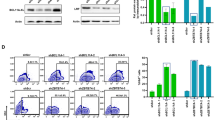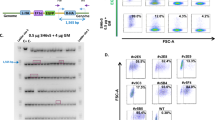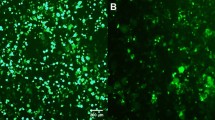Abstract
Adenoviral vector-mediated transient gene expression can provide new possibilities for ex vivo manipulation of quiescent hematopoietic stem cells (HSC). In order to define a suitable expression cassette for high levels of transgene expression in HSCs, we have studied the level of transgene expression in human CD34+CD38− cells using adenoviral vectors with various gene expression cassettes encoding the enhanced green fluorescence protein (EGFP) gene. CD34+ hematopoietic cells were cultured in serum-free medium with megakaryocyte growth and development factor (MGDF) alone for supporting the survival of primitive progenitors or with MGDF, c-kit ligand (KL) and flt3 ligand (FL) for inducing proliferation of primitive progenitors. With all the vectors tested, higher percentages of EGFP expressing cells were found in CD34+CD38− cells than those in CD34+CD38high cells from all donors tested. The phosphoglycerate kinase (PGK)-1 promoter was found to allow higher levels of EGFP expression than the human cytomegalovirus (HCMV) promoter in CD34+CD38− cells. Replacing the SV40 polyadenylation signal with the human β-globin gene IVS2 and polyadenylation signal in the expression cassette (Ad5xPGK-EGFP-β-globin) enhanced the level of EGFP expression markedly further. These results provide a guideline for the development of adenoviral vectors for gene expression in human primitive hematopoietic progenitor cells.
This is a preview of subscription content, access via your institution
Access options
Subscribe to this journal
Receive 12 print issues and online access
$259.00 per year
only $21.58 per issue
Buy this article
- Purchase on Springer Link
- Instant access to full article PDF
Prices may be subject to local taxes which are calculated during checkout





Similar content being viewed by others
References
Fan X et al. Efficient adenoviral vector transduction of human hematopoietic SCID-repopulating and long-term culture-initiating cells Hum Gene Ther 2000 11: 1313–1327
Neering SJ et al. Transduction of primitive human hematopoietic cells with recombinant adenovirus vectors Blood 1996 88: 1147–1155
Takahashi T et al. A potential molecular approach to ex vivo hematopoietic expansion with recombinant epidermal growth factor receptor-expressing adenovirus vector Blood 1998 91: 4509–4515
Byk T et al. Lipofectamine and related cationic lipids strongly improve adenoviral infection efficiency of primitive human hematopoietic cells Hum Gene Ther 1998 9: 2493–2502
Wickham TJ et al. Increased in vitro and in vivo gene transfer by adenovirus vectors containing chimeric fiber proteins J Virol 1997 71: 8221–8229
Shayakhmetov DM et al. Efficient gene transfer into human CD34(+) cells by a retargeted adenovirus vector J Virol 2000 74: 2567–2583
Bergelson JM et al. Isolation of a common receptor for Coxsackie B viruses and adenoviruses 2 and 5 Science 1997 275: 1320–1323
Wickham TJ et al. Integrins alpha v beta 3 and alpha v beta 5 promote adenovirus internalization but not virus attachment Cell 1993 73: 309–319
Bregni M et al. Adenovirus vectors for gene transduction into mobilized blood CD34+ cells Gene Therapy 1998 5: 465–472
Watanabe T et al. Gene transfer into human bone marrow hematopoietic cells mediated by adenovirus vectors (see comments) Blood 1996 87: 5032–5039
Frey BM et al. High-efficiency gene transfer into ex vivo expanded human hematopoietic progenitors and precursor cells by adenovirus vectors Blood 1998 91: 2781–2792
Howard DS et al. Genetic manipulation of primitive leukemic and normal hematopoietic cells using a novel method of adenovirus-mediated gene transfer Leukemia 1999 13: 1608–1616
Hao QL et al. A functional comparison of CD34+ CD38− cells in cord blood and bone marrow Blood 1995 86: 3745–3753
Bhatia M et al. Purification of primitive human hematopoietic cells capable of repopulating immune-deficient mice Proc Natl Acad Sci USA 1997 94: 5320–5325
Borge OJ et al. Ability of early acting cytokines to directly promote survival and suppress apoptosis of human primitive CD34+CD38− bone marrow cells with multilineage potential at the single-cell level: key role of thrombopoietin Blood 1997 90: 2282–2292
Ramsfjell V et al. Thrombopoietin directly and potently stimulates multilineage growth and progenitor cell expansion from primitive (CD34+ CD38−) human bone marrow progenitor cells: distinct and key interactions with the ligands for c-kit and flt3, and inhibitory effects of TGF-beta and TNF-alpha J Immunol 1997 158: 5169–5177
Segerman A, Mei YF, Wadell G . Adenovirus types 11p and 35p show high binding efficiencies for committed hematopoietic cell lines and are infective to these cell lines J Virol 2000 74: 1457–1467
Bett AJ et al. An efficient and flexible system for construction of adenovirus vectors with insertions or deletions in early regions 1 and 3 Proc Natl Acad Sci USA 1994 91: 8802–8806
Hitt M et al (eds). Techniques for human adenovirus vector construction and characterization. In: Adolph KW (ed) Methods in Molecular Genetics Vol. 7: Academic Press: San Diego 1995 pp 13–30
Acknowledgements
These studies were generously supported by the Medical Faculty, University of Lund, the Swedish Cancer Society and The Medical Research Council, Sweden by grants to Stefan Karlsson. The authors gratefully acknowledge Dr Johan Richter and other colleagues at the Department of Hematology (Lund University Hospital) for performing the human bone marrow aspirations and thank our bone marrow volunteers for their donations. We are indebted to Dr Saemundur Gudmundsson and the staff of The Department of Obstetrics and Gynecology, Malmö for collecting umbilical cord blood samples. We thank Drs Ian K McNiece, Janet Nichol (Amgen, Thousand Oaks, CA) for generously supplying MGDF and KL, and Dr Stewart Lyman (Immunex, Seattle, WA) for providing FL for these studies.
Author information
Authors and Affiliations
Rights and permissions
About this article
Cite this article
Fan, X., Brun, A. & Karlsson, S. Adenoviral vector design for high-level transgene expression in primitive human hematopoietic progenitors. Gene Ther 7, 2132–2138 (2000). https://doi.org/10.1038/sj.gt.3301352
Received:
Accepted:
Published:
Issue Date:
DOI: https://doi.org/10.1038/sj.gt.3301352



